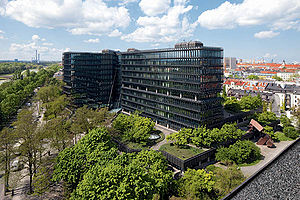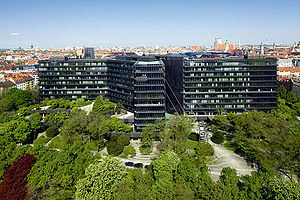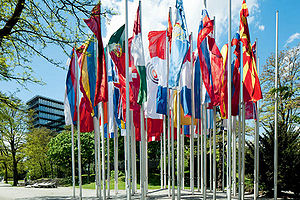
As a body of the European Patent Organisation, the European Patent Office grants patents for inventions, with immediate effect for up to 38 countries - on the basis of the European Patent Convention and after comprehensive assessment of the relevant state of the art. It was founded in 1977. Its registered office is in Munich. There is a branch in The Hague and sub-offices in Berlin and Vienna. In 2009, upwards of 130,000 European patent applications were filed. More than 6,800 people worked in the office at the end of 2009.
Established in 1977
The European Patent Office was established on 1 November 1977. It is a body of the European Patent Organisation, which was founded by the European Patent Convention. It has administrative and financial autonomy (Article 4(1) of the European Patent Convention). So far, it has been completely self-financed through the income of the European Patent Office's fees. Its function is to grant European patents in accordance with the European Patent Convention. The European Patent Office carries out this task under the supervision of the second body of the European Patent Organisation, the Administrative Council, which the European Patent Convention also confers certain legislative powers to (Article 4(2) and (3), Article 33 of the European Patent Convention). It has proved advantageous for the Office's work that the convention designates only English, French and German as official languages - with equal status.
Effect of European patents
The patents granted by the European Patent Office have immediate effect for the contracting states to the European Patent Convention designated therein, i.e. without a national confirmation act. In this respect, the contracting states have transferred sovereign powers to the European Patent Organisation and limited their sovereignty. As a result, the European Patent Convention enables inventors and companies to obtain protection for their inventions in a large number of countries – these days in virtually all of Europe (excluding Russia) – through one single application and a centralised procedure.
The European Patent Convention contains few provisions on the extent of the effects of a European patent. It is therefore largely defined by the national laws of each individual contracting state for which it is issued. This applies in particular to the acts that are to be regarded as patent infringements and the claims that the patentee has against the party infringing their patent.
Legal basis
The European Patent Convention was signed by representatives of 16 of the 21 participating states at the end of a Diplomatic Conference held in Munich at the Maximilianeum , the seat of the Bavarian Landtag from 10 September to 5 October 1973 (signatories: Austria, Belgium, Denmark, France, Germany, Greece, Ireland, Italy, Liechtenstein, Luxembourg, Monaco, Netherlands, Norway, Sweden, Switzerland, United Kingdom; other conference participants: Finland, Yugoslavia, Portugal, Spain, Turkey). The Convention entered into force for seven states on 7 October 1977, after the agreed minimum number of instruments of ratification had been lodged. Since then, it has become applicable to 31 other states through accessions and ratifications.
The creators of the European Patent Convention were able to draw on preliminary work, which had been carried out in particular by the Council of Europe in an effort to harmonise national patent legislations and by the European Economic Community in devising a preliminary draft for an agreement on a unitary patent for the common market, which has still not been implemented today. The European Patent Convention includes a number of protocols and the implementing regulations. Additional regulations, in particular the rules relating to the European Patent Office fees, have been issued by the Administrative Council. The implementing regulations and rules relating to fees have been amended many times by Administrative Council decisions and adapted to the experience and needs that had become apparent while running the European Patent Office.
A Diplomatic Conference on the Revision of the European Patent Convention was held in November 2000. The amendments adopted by it entered into force on 13 December 2007.
Registered office and other locations of the European Patent Office
The registered office of the European Patent Organsation is determined in Article 6(1) of the European Patent Convention to be in Munich. It is also stipulated that the European Patent Office shall be located in Munich and have a branch in The Hague (Article 6(2)). A sub-office of the European Patent Office in Berlin, established by a Protocol that is part of the European Patent Convention, is subject to this branch. Another sub-office was set up in Vienna in 1990 on the basis of Article 7 of the European Patent Convention through an Administrative Council decision and an agreement with the Republic of Austria.
Reasons for the location of the registered office, branch and sub-offices

The European Patent Office grants European patents for inventions in all fields of technology according to the procedure and under the conditions laid down in the European Patent Convention. These primarily include, according to Article 52(1), that the invention for which a European patent is being sought by filing a European application is new and involves an inventive step. Whether these conditions for patentability are fulfilled depends on the state of the art, which comprises all the information that has been made available to the public before the date that determines the priority of the application (Article 54(2)). Before granting a European patent, the European Patent Office must therefore determine the state of the art to the extent to which it may be relevant to the assessment of the invention pending application. If it finds that the invention is not part of the state of the art and does not, in the eyes of a qualified expert, obviously follow from the state of the art , there is a high probability that the invention is new and involves an inventive step and therefore its patent cannot be subsequently revoked or declared invalid for lack of novelty or lack of a sufficient inventive step.
Giving a high degree of reliability to European patents through the preliminary examination of novelty and an inventive step was and is a major concern of the European Patent Convention's contracting states. They also wanted to avoid an unnecessary multiplication of examination work by entrusting it to the European Patent Office as a common body, so that the examination need only be carried out once for all the states for which a European patent is sought, and not separately in each of them. In addition, the European grant procedure also leads to pre-examined and thus more reliable patents for those contracting states whose national authorities do not check for novelty and an inventive step prior to granting a patent, but only in the event of disputes arising after the fact.
Since these objectives can only be achieved if the relevant state of the art is determined for each invention applied for, only a place where the comprehensive documentation necessary for such examinations was available could be considered to become the registered office for the European Patent Organisation and the European Patent Office. The Federal Republic of Germany applied for the establishment of the European Patent Office in Munich, where the German Patent Office, the successor to the Berlin Reichspatentamt, which was closed at the end of the war, had resided since 1949 – at first housed in the Deutsches Museum library building, and, from 1959 onwards, in a new building on the west bank of the Isar (where it still exists today as the German Patent and Trademark Office). Patents had been granted in Germany only after a comprehensive preliminary examination of the state of the art since 1877, and thus the necessary documentation was available in Munich.
However, the Netherlands had also applied for The Hague, where the International Patent Institute had been in existence since 1947. It served the relevant authorities of its affiliated states by providing information on the state of the art, for which it built up comprehensive documentation. The United Kingdom of Great Britain and Northern Ireland had also expressed its interest in seeing the European Patent Office established in London. In the negotiations that preceded the Munich Diplomatic Conference, it was finally agreed to establish the European Patent Office in Munich, to incorporate the International Patent Institute as a branch and to assign a sub-office in Berlin to it (for further details see Kurt Haertel, Commentary on Article 6, in: Friedrich-Karl Beier/Kurt Haertel/Gerhard Schricker (Hg.), Europäisches Patentübereinkommen – Münchner Gemeinschaftskommentar, Köln u. a. 1986, page 3ff., paragraphs 3–12). The incorporation took place on 1 January 1978 and ended the existence of the International Patent Institute as an independent organisation.
The establishment of the Vienna sub-office was prompted by the fact that an international patent information centre existed there. It has been incorporated into the European Patent Office and contributes to its information activities.
Internal structure
The European Patent Office is managed by a President, who is responsible to the Administrative Council, assisted by several Vice-Presidents (Article 10(1) and (3) of the European Patent Convention). Internally, it is organised in five Directorates-General. The Directorate-General Operations is mainly responsible for ascertaining the state of the art (research), the examination prior to granting the patent and the decision on oppositions, through which one can claim- within nine months of the granting of a European patent - that it should be revoked in whole or in part on one of the grounds provided for in the European Patent Convention.
The Directorate-General Appeals is comprised of a Legal Board of Appeal, numerous Technical Boards of Appeal and the Enlarged Board of Appeal. The Boards decide on appeals against decisions in examination and opposition proceedings in accordance with Article 22 of the European Patent Convention. The Enlarged Board of Appeal decides on individual points of law referred to it by the President or a Board of Appeal and may be called upon to review the decision of a Board of Appeal for the serious reasons listed in Article 112a of the European Patent Convention.
The members of the Boards of Appeal are guaranteed judicial independence in Article 23 of the European Patent Convention. The Directorate-General Appeals, although organisationally part of the European Patent Office, therefore has the legal status of a court.
Development of the European patent system
At the beginning of 2011, the European patent system created by the European Patent Convention comprised 38 states, including all 27 member states of the European Union, but also eleven other European states, because the European Patent Office is not an authority of the European Union but a body of the independent European Patent Organisation. Anyone filing a European application can therefore obtain protection for a technical invention by means of one single examination file in up to 38 states through a comprehensively pre-examined European patent. However, the applicant can limit their request for protection to just some of these states. This may be advisable because the perpetuation of protection depends on the payment of annual fees to each state of protection and, in many states, on a translation of the European patent, which must be filed within a short period after it is granted. In terms of quantity, the European Patent Office's volume of work has exceeded all expectations. In 1982, there were 28,967 European applications; for the period after the final expansion of the Office, over 30,000 applications were expected at the time (Haertel, Die geschichtliche Entwicklung des europäischen Patentrechts, loc. cit. 1st instalment, 1984, page 5ff., 31, paragraph 70). According to the annual report by the European Patent Office, 128,709 applications were received in 2005, and 142,810 in 2011. The number of people working in the Office increased accordingly. In 1982 it totalled 1,714; for the period after the Office had been fully expanded, it was expected to be around 2,000 (Haertel, loc. cit., paragraph 71). At the end of 2009, a total of 6,818 people were working for the European Patent Office, 3,718 of them in Munich, 2,710 in The Hague, 274 in Berlin and 112 in Vienna.
The increase in the workload and the number of staff needed to cope with said workload also required a significant geographical expansion. In the first years after its opening, the European Patent Office was housed provisionally in rented premises on the Rosenheimer Berg. In 1980 it moved into a newly constructed building on Erhardtstraße south of the German Patent Office opposite the Deutsches Museum. Since then, further extensive building complexes have been added in Munich in the area of the "Pschorr-Höfe" between Bayerstraße and the railway area.
International relations

Since not only nationals of and companies based in contracting states may file European patent applications, a large number of applications also come from other states, especially from the USA and Japan. The European Patent Office has long been engaged in intensive "trilateral cooperation" with the patent offices of these states. More recently, it has also been developing its relations with the patent offices in China and South Korea. Together with these offices, it is endeavouring to promote a worldwide harmonisation of the rules for the protection of inventions. Together with the European Commission, it is working towards creating a Union patent to be granted by the European Patent Office for the territory of the Union, which is to have unitary validity and the same effects in all Member States of the Union. The European court system, in which Union patents can be enforced and subsequently examined for validity, is to be designed in such a way that it is also available for the enforcement and examination of patents granted by the European Patent Office under the rules which have been in force since its establishment – i.e. not as Union patents.
References
- Zehn Jahre Rechtsprechung der Großen Beschwerdekammer im Europäischen Patentamt. Beiträge zur Entwicklung der Rechtsprechung zum Europäischen Patentübereinkommen, hg. von Mitgliedern der Großen Beschwerdekammer im Europäischen Patentamt, Köln/München 1996.
- Rudolf Kraßer, Patentrecht. Ein Lehr- und Handbuch zum deutschen Patent- und Gebrauchsmusterrecht, europäischen und internationalen Patentrecht, München 6., neu bearbeitete Auflage 2009.
Further Research
External Links
EPA, European Patent Office (EPO), Office européen des brevets (OEB)
Cite
Rudolf Kraßer, European Patent Office (EPO), published 21 August 2012, english version published 22 June 2023, in: Historisches Lexikon Bayerns, URL: <https://www.historisches-lexikon-bayerns.de/Lexikon/EN:European_Patent_Office_(EPO)> (21.12.2025)
